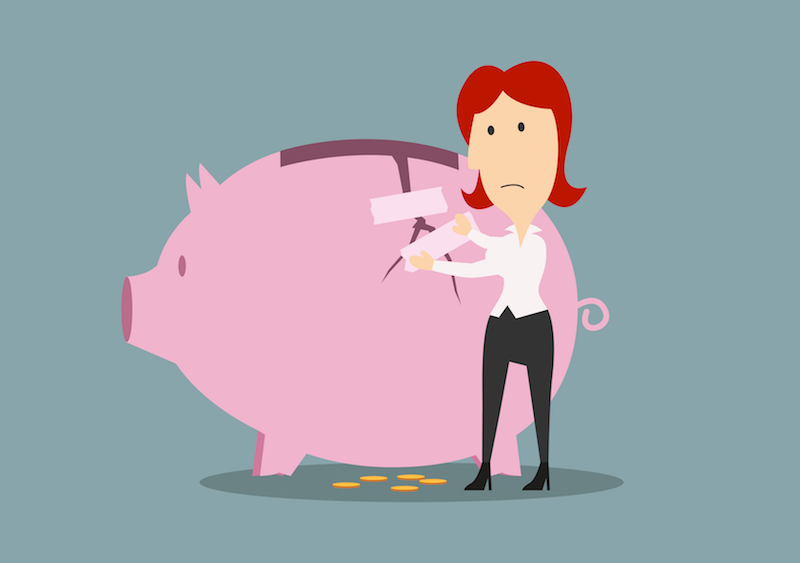
Have you ever had a financial emergency?
Your car starts spewing smoke on the way to work. The pipes burst in the dead of winter and the moisture damaged the walls and floors pretty badly. You didn’t get a tax refund this year like you expected – you actually owe $1,500.
Whatever the situation, you probably felt a sinking sense of helpless in that moment. You may have felt fear, or anger, or sorrow, but beneath all those feelings was likely the helplessness of not knowing what to do.
 How am I going to deal with this? I can’t afford this. What am I going to do?
How am I going to deal with this? I can’t afford this. What am I going to do?
If you’ve ever been in this situation, let us start by saying we’re so sorry you had that experience. We’d like to help make sure you never feel that way again, ever.
The best way we know how is to help make sure you have enough money to cover any emergency that might come up in the future.
I Can’t Afford Savings
Here’s the first objection most people say when we recommend starting a savings account: “I’m already in debt. I can’t afford to set aside money for savings.”
It’s a reasonable thing to say. Being in debt is bad news, particularly if you’re paying high interest rates each money, and it can seem like a much smarter idea to put money toward paying down debt rather than saving a cushion against financial emergency.
Here’s why it’s a good idea to put aside that money for savings nonetheless:
- You protect the progress you’ve made. If you’ve been working toward paying down debt, it can be hugely demoralizing to stack an unexpected expense (like a car repair) on a credit card because you don’t have enough money in your bank account.
If you can pay for that unexpected expense out of pocket, you can continue to chip away at your debt without getting set back.
- You give yourself emotional support. Remember how helpless you felt when you didn’t know how to handle the unexpected expense? Imagine the opposite of that feeling. Imagine feeling like this is not convenient at all, but you know what? It’ll be okay.
This is what saving money really means: “I planned for this. I’ve got it under control.” That confidence is invaluable to you!
Let’s not underplay this: You’ll definitely save yourself some interest payments if you use the $1,000 you might set aside for emergencies and pay down your debt with it instead.
You know yourself best, so think about these two options:
1) If you know that you’d get knocked off track if your debt suddenly increased substantially after you’ve spent months working hard to pay it down, put the effort into building up savings.
2) If you know you could handle any emergency that happens out of the blue without resorting to credit cards to get you out of a jam… then why not set aside a bit of money towards savings? It only makes sense!
Where to Find the Money
If you aren’t used to setting aside money towards savings, it can be difficult to figure out where the extra money might come from.
If you’re already budgeting, take a hard look at your expenses and see if you’d be willing to give up a small indulgence to feel safer and more secure at the end of a year’s work.
You can also try to find a small source of income, if your budget is already pretty tight. An extra $20 a week isn’t too hard to find if you’re motivated: dog walking, gardening, or cleaning are all gigs that most people need regularly. One small freelance job a month or taking on an extra client can also do the trick.
If you can find $20 every week to put toward your savings goal, you’ll have a $1,040 in that savings account to cushion you against emergencies by the end of the year.
If you can find $200 a month for your savings? You’ll be at your goal before six months are up!
Automatic Money-Designation
It can help to set up a sort of ‘code’ for your savings money – a certain kind of money that you know is always designated for savings.
For example, if you decide to take up housecleaning for a few extra bucks, you might decide that every penny you earn while cleaning is always earmarked for savings.
You can also use this trick to “find” money for your savings account within your regular spending.
Danielle is designer who works on the side as a barista to build up her savings. She keeps every $20 bill she gets from the tip jar in a separate compartment in her wallet – smaller bills go toward day-to-day expenses, but the $20s are never broken.
Once she has five $20 bills, she trades them in for one $100 – a bill that’s even more difficult to break! She puts that $100 in a hidden compartment in his house. After several years, Daniel’s stack has grown to over $5,000, and she’s ready to start investing that money.
This strategy of setting aside specific bills is a sound one. Many people save their loose change in a similar way, but you could decide that all $5 or $10 bills you acquire are sacred to your savings goal.
Once you’ve decided those bills are off-limits because they’re already designated for savings, it becomes easy not to spend them.
What to Do Once You Reach Your Savings Goal
Got enough in your emergency account that no emergency could catch you off-guard? Time to start putting those extra funds toward your next goal. You’re already in the habit of setting that money aside, so put it to good use!
If you ever need to dip into your emergency fund, simply re-allocate those funds until your emergency fund is comfortably full again.
Notice something, too: Knowing exactly what you’ll do when an emergency crops up is a powerful feeling of security. You can’t avoid an unexpected expense – but you can make sure that when that emergency happens, you can handle it easily.
Want to learn more about protecting yourself, finding ways to save for your goals, and building better financial security?
Check out our latest offer, the Money Map Coaching Program. This interactive program teaches you a solid framework that helps you make smart financial decisions, map your money goals, and start moving towards the life you want to have.

